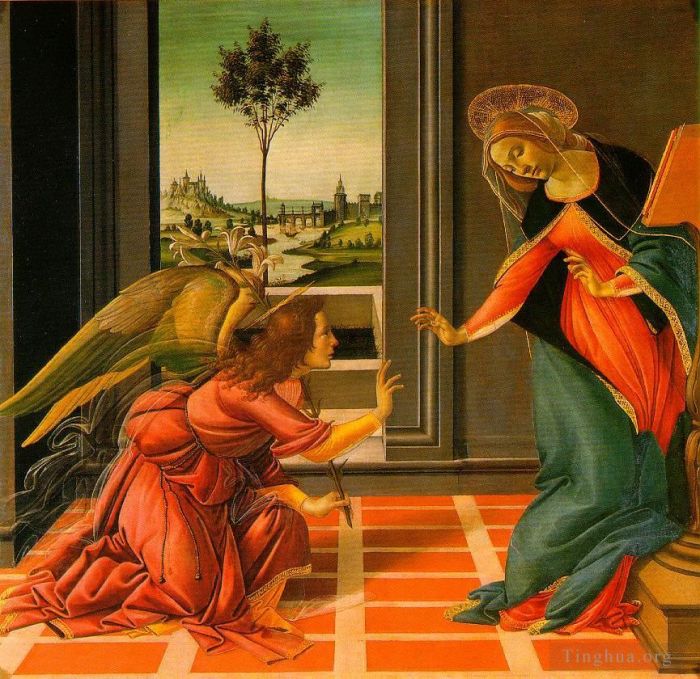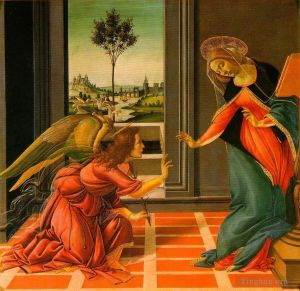The Cestello Annunciation
Sandro Botticelli
- Price: Price on Request
- Art Type: Various Paintings
- Size:
- English Comments: 0
- International Comments: 0
- Creating Date:
- Introduction and Works of Sandro Botticelli >>
Keywords:
Cestello, Annunciation
Work Overview
- The Cestello Annunciation
Artist Sandro Botticelli
Year 1489
Medium Tempera on panel
Dimensions 150 cm × 156 cm (59 in × 61 in)
Location Uffizi, Florence
The Cestello Annunciation, is a painting in tempera on panel made in 1489 for the church of the Florentine monastery of Cestello, which is now known as Santa Maria Maddalena de'Pazzi.[1][2]
The subject of the painting is the Annunciation, in which the angel Gabriel visits the Virgin Mary to 'announce' to her (hence 'Annuciation') that she has been chosen by God to bear the Christ child should she accept this invitation. Her 'fiat' (Let it be done to me) is her response. Underneath the painting on its original frame are words in Latin from St. Luke's Gospel 1:35 "The Holy Ghost shall come upon thee, and the power of the Highest shall overshadow thee."[3]
The subject of the Annunciation is common in Christian art[4][5] and has been depicted by many artists, in multiple formats, and in different time periods. In addition to the Cestello Annunciation, Botticelli also painted a 1485 Annunciation now in the Metropolitan Museum of Art[6] and a 1495-1500 version now housed in the Kelvingrove Art Gallery and Museum.
Sandro Botticelli (1445 - 1521) is, beyond a doubt, one of the most beloved artists of the Uffizi Gallery. His Birth of Venus and Primavera are the Uffizi symbols, known throughout the world.
However, in the Florentine museum other works by the master are housed. These paintings are less famous, but they occupy an important place in art history, they are among the masterpieces of Italian painting. The new setup of the Botticelli room also aims to allow visitors to observe them carefully.
The Cestello Annunciation is one of these works. The tempera on panel painting was made in 1489-90 for the Guardi family chapel in the monastery church of Cestello in Pinti. The painting has been at the Uffizi since 1872. In 1986 it was restored.
The work represents the moment in which the angel arrives to the Virgin Mary. We notice this from its veil, yet relieved. Mary was reading, but she turns to the man. The two exchange deep looks. The angel holds out to the young woman a white lily, that is the symbol of her purity. The two figures are represented dynamically, both pictured while they are moving.
The scene takes place in an interior, which opens onto a landscape heavily inspired by Flemish painting of that period. There is a river and two castles, connected by a bridge.
Botticelli painted this work in a period during which the influence of Girolamo Savonarola (1452 - 1498) was strong on him. We notice it especially from the drama that emerges from the two protagonists of the painting.
- Copyright Statement:
All the reproduction of any forms about this work unauthorized by Singing Palette including images, texts and so on will be deemed to be violating the Copyright Laws.
To cite this webpage, please link back here.
- >> English Comments
- >> Chinese Comments
- >> French Comments
- >> German Comments
- >>Report
- Pallas and the centaur
- The Calumny of Apelles
- Killing the woman (The Story of Nastagio degli Onesti - second episode)
- Nastagio meets the woman and the knight in the pine forest of Ravenna (The Story of Nastagio degli Onesti - first episode)
- The Birth Of Venus
- Primavera
- Discovery of murder Holophernes
- The banquet in the forest (The Story of Nastagio degli Onesti - third episode)
- Madonna And Child With An Angel 2
- Sandro Portrait of a young man
- Portrait of a young man
- Madonna In Glory With Seraphim
- The Temptation of Christ
- The Discovery Of The Murder Of Holofernes
- The Cestello Annunciation
- Adoration of The Magi
- Madonna della Loggia (Madonna and Child)
- Marriage of Nastagio degli Onesti (The Story of Nastagio degli Onesti - fourth episode)
- The Trials of Moses (The Youth of Moses)
- Madonna and Child with Six Saints (Sant Ambrogio Altarpiece)
- Portrait of a young man 1483
- Madonna And Child With An Angel
- Portrait of an young woman
- Venus and Mars
- Punishment of the Rebels (The Punishment of the Sons of Corah)
- Adoration Of The magi
- Madonna of the Rose Garden
- Simonetta
- Virgin and Child with an Angel (Our Lady of the Eucharist)
- Madonna And Child And Two Angels
- The Return Of Judith To Bethulia
- The Mystical Nativity
- Fortitude
- Sixtus II
- Guliano de Medici
- Madonna of the Book (The Virgin and Child)
- The Virgin And Child With Two Angels
- Madonna of The Magnificat
- Madonna with Child and five angels (The Virgin and Child surrounded by Five Angels)









 Singing Palette
Singing Palette